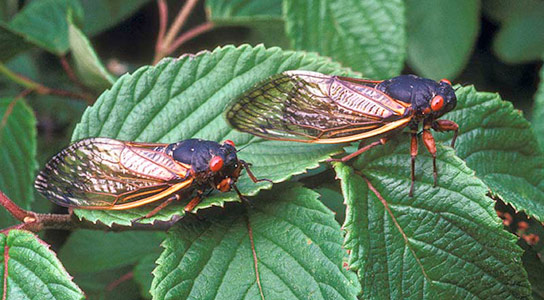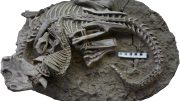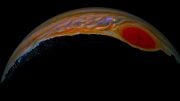
Periodical cicadas manipulate the populations of birds that eat them. Credit: ARS/USDA
Periodical cicadas emerge in North America every 13 or 17 years. Scientists think that the cicadas’ cycles are timed to “engineer” the number of predatory birds. The populations of these birds drop significantly the year that cicadas emerge.
Walt Koenig, a behavioral ecologist at Cornell University and the lead author of the paper, published the findings in the journal The American Naturalist¹. American colonists first reported this strange behavior in the mid-1600s. All of the periodical cicadas species follow the same basic life cycle, living underground as nymphs for 13 or 17 years, and then emerging en masse in great numbers in the summer.
The cicadas crawl up trees, shed their skin, and become glass-winged adults for a few weeks, that mate and lay eggs. After the eggs hatch, the nymphs once again descend into the ground. In the early 20th century, researchers had shown that avian predators could wipe out an entire population of cicadas that emerge out of sequence; so the scientists took a look at how bird populations might affect the insect cycles in this new study.
15 bird species were targeted, including yellow-billed cuckoos, red-headed woodpeckers, and house sparrows. All of these species eat cicadas. The analysis showed that the birds’ populations reached their lowest point in the year that the insects emerged. This suggests that avian predators aren’t exerting much pressure on the cicadas. 12 years after the cicadas emerged, the birds went into decline, eventually reaching their lowest point at year 17, just as the cicadas were emerging again.
The birds feeding on the 13-year-cycle cicadas followed a similar path. Their numbers also reached their lowest point at the time of emergence, and began to increase immediately after the cicadas appeared. “The cicadas are driving the birds’ populations; they’re setting the birds on a trajectory that leads to significantly lower populations at the time of the next emergence,” Koenig says. The timing of the cicadas’ cycles is all about manipulating their predators—and “may have nothing to do with these being prime numbers,” he emphasizes.
The biomass of cicadas has an enormous effect on the environment, enriching everything from soils, trees, and birds. The aftermath of these emergences lasts longer than suspected. Avian predation has long been recognized as a factor in these cycles and Koenig suggests a way for it to work together with other ecological factors to produce the synchronized and long 13- and 17-year life cycles.
The scientists still don’t have a good theory why the cicadas’ resource pulse causes the birds’ populations to reach their low point exactly at 13 and 17 years.
Reference: “Avian Predation Pressure as a Potential Driver of Periodical Cicada Cycle Length” by Walter D. Koenig and Andrew M. Liebhold, 27 November 2012, The American Naturalist.
DOI: 10.1086/668596









Be the first to comment on "Periodical Cicadas Manipulate the Populations of Predatory Birds"